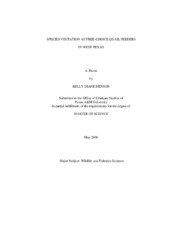| dc.description.abstract | Providing supplemental feed is a popular management practice for quail
(northern bobwhite Colinus virginianus and scaled quail Callipepla squamata )
in Texas. It is common knowledge that non-target species, e.g., raccoons
(Procyon lotor), are frequent visitors at feeding stations intended for quail.
However, empirical data are scarce on seasonal visitation rates at such feeders,
either by quail or by non-target species. The ecological efficacy and economic
efficiency of a feeding program for quail depends on several variables; perhaps
the most important of these is how much of the feed is consumed by quail
versus various non-target species. I monitored species visitation seasonally at
free-choice quail feeders with motion-sensing cameras at 4 sites in West Texas
(Coke, Fisher and Stonewall counties). Quail feeders were monitored using
active-infrared sensing camera systems and passive-infrared video systems, to
compare data obtained via these 2 surveillance techniques. I tested 2 research
hypotheses: 1) that quail feeders are visited by a wide range of non-target species; and 2) active-infrared surveillance will yield a more precise estimate
of species visitation than estimates derived from passive video surveillance.
Major findings included documentation of approximately 14 mammalian
and 18 avian species that were recorded in a total of 6,558 events. Data analysis
yielded a chronology of feeding behavior by all visiting species. I found that
species visitation at quail feeders varied according to season, with the greatest
number of events occurring during the fall and the fewest during the winter.
Feeder visitation also varied according to lunar phase, with the fewest events
occurring during the new moon phase. I recorded the duration of each event
monitored on videotape, a total of 29,235 minutes, and determined that feeder
visitation by raccoons comprised 43.2% of all time spent at quail feeders across
all species. Visitation by bobwhite and scaled quail comprised only 5.4% of
time spent at quail feeders by all visiting species. This study confirmed the
need for strategy implementation that minimizes non-target consumption of
feed intended for quail. | en |


